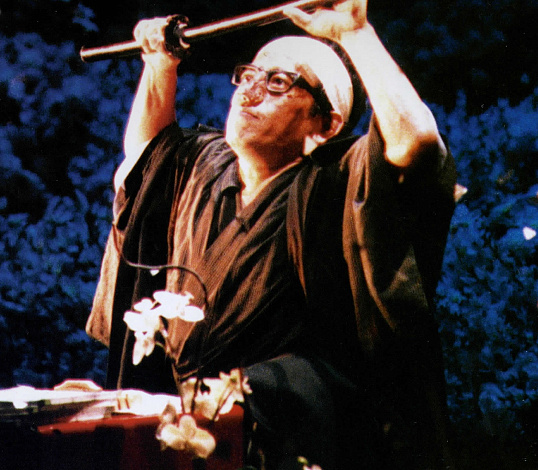| Cast | Hideo Kanze, Takao Nishimura, Minoru Shibata, Kan Hosho, Makoto Ono, Mitsuhisa Hayashi, Yoshikatsu Tsukuda, Tetsunojo Kanze, Tadashi Nagashima, Nobujuki Yamamoto, Noboyuki Abe, Kanjl Shimizu, Reiji Okada, Masaki Umano, Keizo Nagayama, Kengo Tanimoto, Seigo Mikuriya |


NOH Theatre Modern Japanese theatre unites various theatrical forms, fr om traditional up to modern or western theatres. Like Kabuki and Bunraku, Noh is one of the major classical theatre arts in Japan. It connects elements of dance, drama, music and poetry in highly aesthetic scenic action. Originally Noh performances were held on religious festivals. Noh blossomed in the 14th century and during Japanese feudalism under the protection of military leaders and their masters (shogun). Its aesthetic principles were developed by the outstanding actor and playwright Kan'ami (1332-1384) and his son Zeami (1363-1443). All actors are men; the actors playing female parts frequently wear masks. The basic roie in the No play is called ‘shait’: he is accompanied by one or several people called 'tsur1. in many plays shait appears in the first half as a normal person, and then in second half in his/her real form as spirit or a ghost of the past. At the first appearance he is called ‘mae-jait', at the second ‘nochi-jait’. The supporting roles are named 'vaki' and usually belong to the travelling priest who asks shait questions and thus hears the story about the event. The chorus ‘jutai’ sits sideways from the stage and narrates what happened before and also explains the ideas and emotions of the main character. In the performance the musicians, the so-called 'hayachi-kata', offer musical support which is performed on a flute, 'fue', drums, ‘ko-tsusumi’, ‘o-tsusumi’, and ‘taiko’ (sometimes unused). During the 17th-19th centuries the No theatre became stable and stationary. Above the main stage a bent roof rises, like a roof on a temple, which extends also above the lateral stage and above the backstage. A bridge (‘hashigakari’) connects the main stage to the inclined corner, whence actors and musicians enter and leave. On the back wall the sacred pine is represented, wh ere, according to a belief, God descends. Today the performances of the Noh theatre take place in modern buildings, but the stage keeps the traditional forms.
Hideo Kanze (shait, the main actor) was born in Tokyo in 1927; he is the descendant of the master of 14th-century No theatre Kan’ami and his son, the actor and playwright Zeami. Mister Kanze started to train in the art of No at the age of three years under the direction of his father and grandfather; he acted professionally for the first time at the age of four years. In 1949 he enrolled at the school in Kita, and later, in 1958, he left the National Association of No. Since then Mister Kanze searches between traditional and modern forms of scenic arts, cooperating with such actors as Tetsuji Takechi, Tadashi Suzuki and with many others. In 1978 he again returned to No theatre. Mister Kanze regularly works in traditional and modern theatre inside the country and abroad.
Hosho Kan (vaki, the second actor) was born in 1934, as a descendant of one of the main actor's families of vaki. He started to practice vaki-kata (form) under the direction of his father and grandfather, and for the first time he acted at the age of nine. In existing circles of the No theatre he is recognized as one of the most outstanding actors of vaki-kata. He acts both in classical and in modern repertoire of Noh theatre.
Kagikiyo is one of the most common heroes of No and Kabuki plays. The sources for the plots of these plays lie in the uncountable legends about this person with a tragical destiny. His name gave legends an allegorical character: the word ‘kage’ designates light and his name was considered as expression of the painful aspiration of a blind man to light. Taira Kagekiyo (?—1196) was a military leader of the end of the Heian epoch (794-1192), and the beginning of the epoch Kamakura (1192-1336). At the end of the Heian epoch there were disagreements between the two most influential families, Heike (Taira) and Gendzi (Minamoto), which have resulted in wars involving all of Japan. The victory in this war was gained by Gendzi. Having transferred the capital from Kyoto to Kamakura, he established the first military government in Japan. Kagekiyo was Heike's military leader and fought against Gendzi in battles all over Japan; however, in 1195, because of a series of unsuccessful battles, he surrendered to Minamoto Yoritomo. In the following year he committed suicide, having refused food.